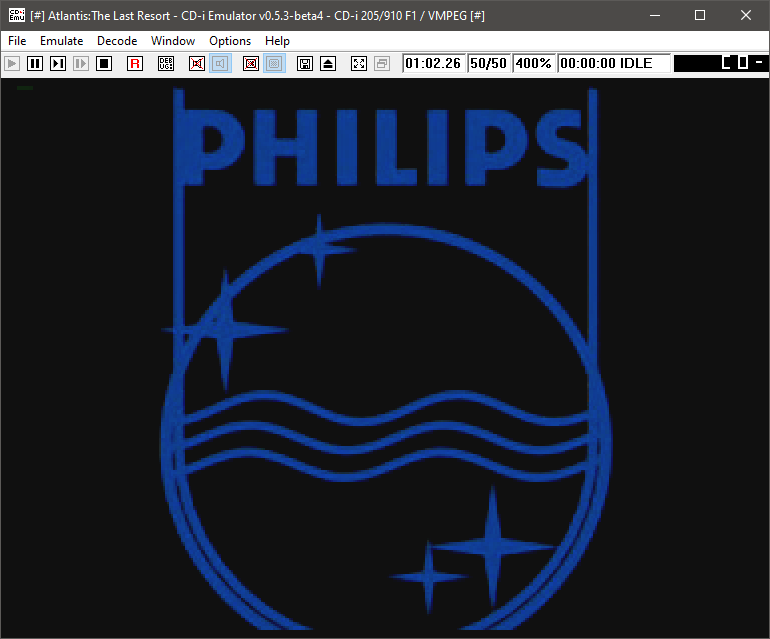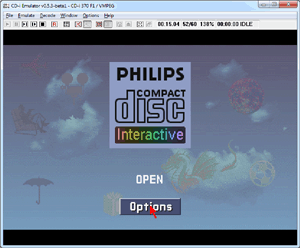
Regarding the opening and closing of the drawer, the belt can be replaced quite easily (half an hour or so) if you take your time and can be purchased from most good electrical retailers i.e Maplins. In reality it is a combination of the drawer sliders become dry causing it to become difficult to open and also squeak and probably a stretched belt, this can be rectified with a few drops of 3-in1 oil on the drawer sliders and on the cog in the middle. It is thought that the drawer on most CD-I’s stick and causes a problem for the drawer to open and close. The system itself, I th ought, was not to bad and had a good build quality about it as well as being able to play music, illustrated encyclopedias and CD-i films which there was a vast library of.Ī downside to the CD-i, I thought, was that films could only be played via the Digital Video Cartridge that was an add-on, and inserted at the rear of the console.

PHILIPS CDI EMULATOR PORTABLE
The main difference to this unit though was that it was built by LG Electronics (then Goldstar) but was based on their own portable CD-i.Īlthough most of the games written or ported for the CD-i were not very good, there is a cult following of the Nintendo-related games. The unit was more compact that the other units and featured a rechargable battery and an intergrated Digital Video Decoder. It still required the 9142 docking station but featured a high quaility Philips LCD display making it the first all in one CD-i. The CD-i 360 i personally thought was the one to get. The CD-i 350 was basically the same as the 310 requiring a 9142 docking station but the unit had a Sharp LCD screen built in. The unit however did not have any kind of display or Digital Video Cartridge (DVC) so a 9142 Docking Station was Required. The CD-i 310 was the basic portable model featuring an intergrated 3.5″ floppy drive. Later, four portable models were released that i know of and are quite rare.
PHILIPS CDI EMULATOR SOFTWARE
Some models can also be connected to an emulator and be used for software testing and debugging. Units in this line generally include support for Floppy disk drives and keyboards as well as other computer peripherals.
PHILIPS CDI EMULATOR PROFESSIONAL
The 600 series was designed for professional applications and software development. It was in this version that a infrared remote control was not standard but optional. The CD-i 450 player was a budget model designed to compete with game consoles. The 400 series were slimmed-down units aimed at console and education markets. The Philips CD-i 400 series includes the 450, 470 and 490 models. A popular use for this range was by pharmaceuticals to provide product information to physicians, as the devices could be transported by sales representatives.


The 300 series consists of portable players designed for the professional market and not available to home consumers. The Philips CD-i player 300 series includes the 310, 350, 360 and the 370 models. The Philips CD-i 910 was the most basic American version compared to that of the CD-i 205. These models in the 200 series were designed for general consumption, and were available at major home electrical stores around the world. The Philips CD-i player 200 series includes the 205, 210 and 220 models. The CD-I video discs and not he interactive discs will play on most formats like the 3Do, Amiga CD32, PC’s and Apple MAC’s with MPEG as far as I’m aware. In advertising, Philips highlighted and pushed the CD-i’s Multimedia applications that the system was capable of performing. Initially, the Philips CD-i was not really promoted as a gaming platform although many hundreds of gaming titles were released. Because of this a provisional standard called The Green Book was later issued in May. In March 1986, the first public announcement was made of a new product – Compact Disc Interactive in the first industry conference in the US to promote CD-ROM. The Philips CD-i (Compact Disc Interactive) player was a 16-bit CD ROM based system that was released to us in 1991 priced $699.00.


 0 kommentar(er)
0 kommentar(er)
